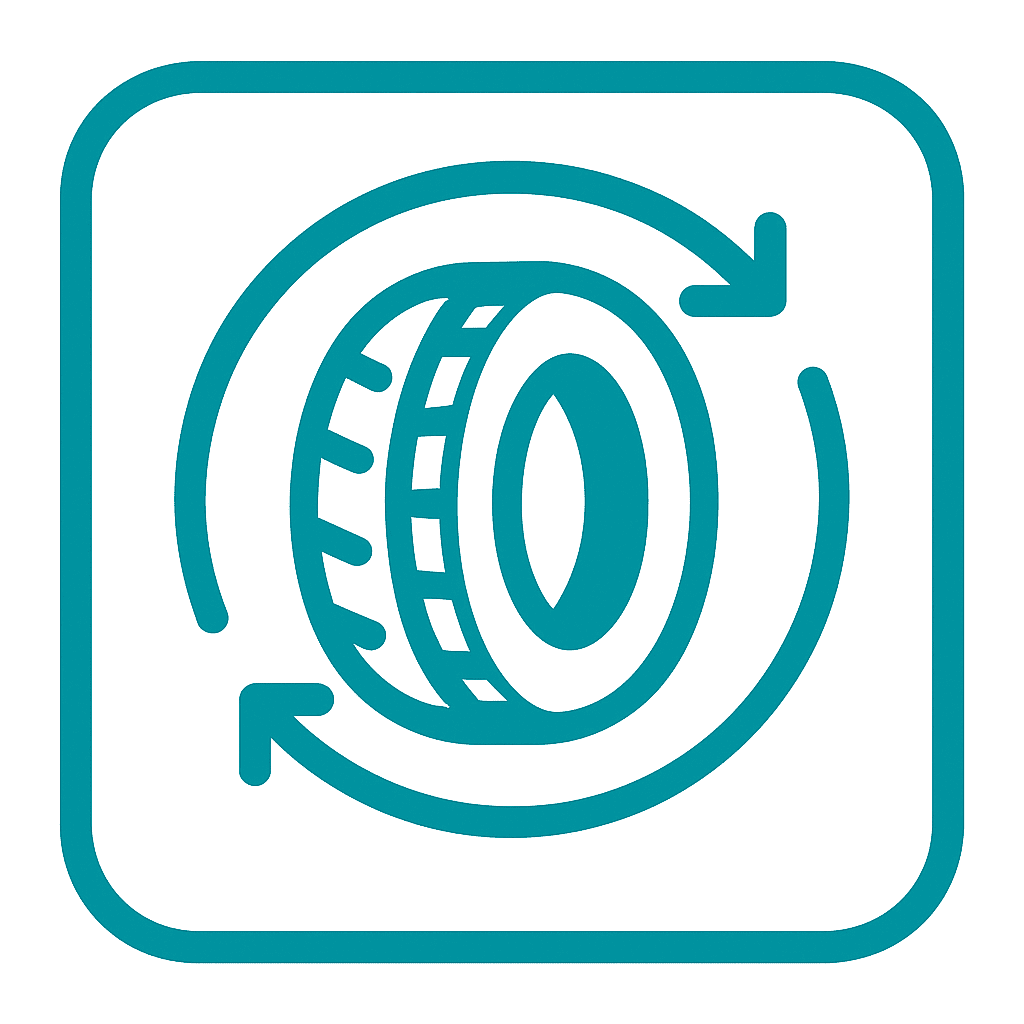Why Rotate Tires?
Front and rear tires do different jobs. On most cars the front tires steer and handle most of the braking load. That creates different wear rates between axles and between left and right sides. Moving each tire periodically evens out those differences, which extends tread life and keeps handling predictable.
That claim isn’t guesswork. The National Highway Traffic Safety Administration advises drivers that “If recommended by the vehicle manufacturer, rotate tires every 5,000 to 8,000 miles or sooner if uneven wear appears.” (NHTSA)

When To Rotate Tires: Practical Intervals
Manufacturers and tire makers give slightly different windows, but they cluster tightly. Here are frequently cited intervals:
- Michelin: “You should rotate your tires approximately every 6,000 to 8,000 miles (about 9,600 to 13,000 km).” (Michelin)
- Goodyear: “If no recommendations are found, Goodyear recommends rotating your tires every 3,000 – 6,000 miles to eliminate premature tire wear…” (Goodyear)
- Consumer Reports: typical guidance is “every 5,000 to 8,000 miles.” (Consumer Reports)
Pick a schedule that fits your car and driving: many owners align rotation with oil changes at roughly 5,000–6,000 miles. AWD vehicles sometimes need shorter intervals because all four driven wheels share torque; check your owner’s manual for the factory recommendation. (NHTSA)
Common Tire Rotation Patterns
Tire rotation pattern selection depends on drivetrain, whether tires are directional, and if your vehicle uses staggered wheel sizes. Here are the standard patterns used by professionals and shops.
- Forward Cross (common for front-wheel drive): Front tires move to the rear on the same side. Rear tires cross to the front (right rear goes to left front, left rear to right front). Use this pattern when front and rear tires are the same size and the car is FWD. (Tire Rack)
- Rearward Cross (for rear-wheel or 4WD): Rear tires move forward on the same side. Front tires cross to the rear. (Bridgestone Tires)
- X-Pattern: Each tire moves diagonally (front left → rear right, etc.). This is a simple option when all four tires are identical and interchangeable. (Tire Rack)
- Side-to-Side (for directional tires): Swap left and right on the same axle only; do not flip a directional tire onto the opposite rim direction. Use this when tires are directional or staggered. (Tire Rack)
- Five-Tire Rotation: If you have a full-size spare that matches the other four tires, include it in rotation so wear stays balanced across five positions. Bridgestone’s guidance covers this pattern for matching spares. (bridgestoneamericas.com)
When someone asks how to rotate tires front to back, the simplest answer is to follow the pattern recommended for your drivetrain and tire type. If in doubt, consult the vehicle owner’s manual or a tire manufacturer’s chart. (Tire Rack)
How Rotation Prevents and Helps Fix Uneven Tire Wear
Tire tread tells a story. Different wear shapes point to specific root causes:
- Center wear: excessive inflation.
- Edge wear (both shoulders): underinflation or heavy cornering.
- Feathering: usually a sign of improper toe alignment.
- Cupping (scalloping): worn shocks/struts or imbalance.
- One-side wear: camber issues or suspension damage. (Bridgestone Tires)
Rotation does not repair tread that is already damaged. It spreads wear so no single tire takes a lifetime of stress. If you already see uneven tire wear, rotation may buy time and stabilize handling, but fixing the underlying cause is required to stop reoccurrence. Typical corrective steps include checking pressures, balancing wheels, and addressing alignment or suspension faults. Experts state plainly that rotation “helps prevent uneven wear,” but alignment and suspension work are often needed to fix existing patterns. (rnrtires.com)
When your goal is to fix uneven tire wear, follow this sequence: check tire pressure and inflation settings, rotate the tires according to the correct tire rotation pattern, then have alignment and balance checked if irregular wear remains.
Tire Balancing vs Alignment: Short, Clear Differences
Tire balancing and wheel alignment are different services that both affect wear and ride quality.
- Tire balancing corrects unequal weight distribution in the tire/wheel assembly. Firestone describes it as a service that “corrects uneven weight distribution in the wheels by adding small metal weights.” Balancing reduces vibration and can be checked when you rotate tires. (firestonecompleteautocare.com)
- Wheel alignment adjusts suspension angles so tires contact the road at the right geometry. Bridgestone explains that alignment is distinct but often performed alongside balancing. Poor alignment accelerates certain wear patterns and can make steering pull to one side. (Bridgestone Tires)
When to balance tires? Best practice: balance whenever tires are replaced, any time you feel speed-related vibration, and commonly when you rotate tires if the shop recommends it. Typical alignment checks are done annually or after a collision or when you detect drift, uneven wear, or steering wheel off-center. (Michelin)
DIY Tire Rotation: Tools, Steps, Safety Notes
DIY tire rotation is possible for people comfortable with basic automotive work, jack stands, and torque wrenches. If you prefer to do it yourself, here’s a safe, practical method that follows the “rotate tires front to back” idea for a simple cross or front-to-rear move.
Tools you need:
- Car jack and rated jack stands
- Lug wrench or breaker bar
- Torque wrench (for correct lug torque)
- Chalk or masking tape to mark current positions
- Wheel chocks and gloves
Step-by-step (example: cross pattern on an interchangeable set):
- Park on level ground, apply parking brake, chock the wheels.
- Slightly loosen lug nuts on all four wheels with the car still on the ground.
- Raise one corner with the jack, place jack stand, finish removing the wheel. Repeat for each wheel, one at a time.
- Swap tires in the chosen pattern (front left → rear right, etc.).
- Hand-thread lug nuts, lower the car, torque lug nuts to the vehicle manufacturer’s spec with the torque wrench.
- After rotating all four, drive 50–100 miles and re-check torque.
If you are not fully confident using jack stands or torquing lug nuts properly, do not proceed. Safety and correct torque on lug nuts are non-negotiable. Several dealer and service sites offer step-by-step DIY guides and illustrations. (Honda of Escondido)
Professional Tire Rotation And Typical Costs
Many shops offer a professional tire rotation as a quick service. Costs vary by region and whether balancing or inspection is bundled. Reported ranges in the U.S. include:
- Low end: about $20.
- Typical: $20–$50 for rotation alone.
- Jiffy Lube / KBB / AutoZone type estimates put rotation between $20 and $75, and rotation with balance higher (often $100+). RepairPal and KBB give higher average ranges when labor is included. (AutoZone.com)
Some retailers include free rotations with tire purchases or membership benefits (Costco, Discount Tire, Les Schwab, etc.). If you rotate regularly, ask whether the service includes a tire inspection, torque check, and whether balancing is recommended at the same visit.
Tire Maintenance Checklist
A practical checklist keeps tires healthy and on schedule. Add this to your routine service planning.
- Check tire pressure regularly. Use the vehicle placard (door jam) for recommendedpsi. check tire pressure regularly.
- Inspect tread depth every month and before long trips. Use a gauge or the penny test.
- Look for signs of uneven tire wear and note patterns. tire wear patterns explained helps you identify causes. (lesschwab.com)
- Rotate tires on your chosen interval. If you perform DIY tire rotation, mark dates and mileage.
- When you replace tires, request balance and alignment checks. Know the difference: tire balancing vs alignment. (firestonecompleteautocare.com)
- Keep wheel lug torque within spec after any rotation or service.
- Replace tires that have reached the legal tread depth limit or show irreparable damage.
Tire Storage Tips
If you swap seasonal tires or keep a spare set, store tires so they stay usable:
- Clean tires and wheels before storage to remove grime and brake dust.
- Keep them in a cool, dry place out of sunlight and away from ozone sources (motors, generators).
- Store tires standing upright when off rims, or stacked flat when on rims. Rotate stacks occasionally to avoid flat spots.
- Wrap tires in opaque plastic bags if storage will exceed a few months to reduce ozone exposure. (Tire Rack)
Final Considerations
Tire rotation is one of the most cost-effective maintenance steps you can do. Quoting Michelin again: “You should rotate your tires approximately every 6,000 to 8,000 miles.” That recommendation sits alongside other respected guidance—NHTSA’s 5,000–8,000-mile window and Goodyear’s lower bound if you lack factory guidance—so pick an interval that matches your driving, check tire pressures often, and inspect tires for uneven wear. (Michelin)
If you spot uneven tire wear, rotation helps stop wear from concentrating on a single corner, but you should address root causes such as alignment, balance, pressures, or suspension faults. Use the tire rotation pattern recommended for your drivetrain and tire type, and weigh DIY tire rotation against professional tire rotation when safety, tools, or confidence are limiting factors. Typical tire rotation cost is often modest, and some retailers include rotations when you buy tires there. (rnrtires.com)
If you want, I can draft a one-page printable tire maintenance checklist you can keep in your glove box, or create a simple 6-step DIY rotation diagram tailored to your vehicle’s drivetrain and tire type.





